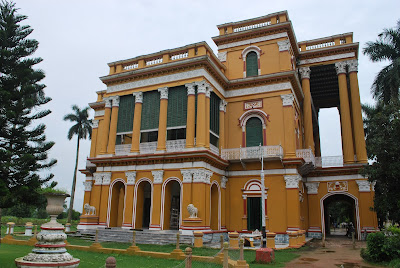A Decade of Travel - 4
2014 – Murshidabad
2014 is an
important year in my life. I began Life 2.0
22nd
September
A train
that goes by the romantic name of Lalgola Express leaves Sealdah 30 minutes
before midnight each day. I boarded that train on 21st September. I
was in a First Class coupe (there are no AC coaches in the train) and did not
sleep well, afraid I might miss my station and go all the way to Lalgola. The
train reached Murshidabad punctually at 4 in the morning. As assured by the
hotel, a transport was awaiting me at the station. To my utter surprise it was
an electric autorickshaw. The autorickshaw would take me to all the sights
during the day.
The hotel
was right on the bank of Bhagirathi. The hotel gate was locked and the
caretaker was fast asleep. Fortunately for me, a passerby at that early hour
managed to create a ruckus to arouse the caretaker and I was admitted in. I had
a room facing the river. A fierce thunderstorm greeted the breaking dawn.
Though the rain stopped at eight, the sky remained overcast all day. In a way,
it was good for photography as I didn’t have to worry about the angles.
There is so
much to see and absorb in Murshidabad. It was, after all, the prosperous capital
of the Nawabs of Bengal, till its decline starting with the defeat of
Siraj-ud-Daulah at Plassey in 1757. Jagat Seth, a wealthy merchant and moneylender,
played a key role in plotting the downfall and killing of Siraj-ud-daulah. His
home along with its sprawling complex of gardens, fountains and nude marble
statues is now a museum.
Katra
Masjid, an imposing brick structure built in 1723, was a great seat for Islamic
learning and could accommodate 700 scholars. It was built by the Mughal
governor Murshid Quli Khan, after whom Murshidabad is named. His tomb is in the
Masjid complex. A very able guide rattled off names and history as he showed me
around the complex. I learned that he is a part-time teacher.
Near the
Masjid is a legendary canon “Jahan Kosh” (Destroyer of the World). Weighing 7
tons and 17 ft long, it was built in 1637.
I crossed
Bhagirathi, on a rather dicey raft, to visit the 250-year old “Char Bangla” terracotta
temples. Commissioned by Rani Bhavani, the carvings on the panels are breathtaking.
Murshidabad
is replete with history and palaces and graveyards are scattered all over the
place. The list of must-see sights goes
on and on. Crowning the list is the Hazarduari Palace. Built between 1824 and
1838, it is the most imposing edifice in Murshidabad, a pure indulgence in Italian
Marble. It is now a museum housing the vast collections of objects and
paintings of the Nawabs. It will need easily half a day to browse through.
As a matter
of principle, I don’t visit a place again. Murshidabd is a glorious exception;
I went back again in 2015. It is totally inexplicable.
One
particularly fond memory of this trip is playing bridge with the hotel owner
and his friends.














Comments
Post a Comment